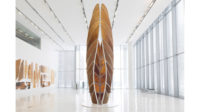| Image courtesy OPEN Architecture |
|
Garden School, Beijing, China by OPEN architecture. Click on the slideshow button to see more images. |
A 45,000-square-meter public middle school designed by OPEN architecture breaking ground in August in the new town of Changyang, in Beijing’s Fangshan District. The competition-winning design is the first major commission for partners Li Hu (who had been a partner at Steven Holl Architects) and Huang Wenjing (who had worked for Pei Cobb Freed & Partners).
The project is part of an initiative spearheaded by Wang Shi, head of Vanke, China's largest real-estate developer, to create 10 significant buildings in China. Vanke co-funded the project, which is called Garden School, with the Fangshan government and co-developed it with COFCO Corporation.
Garden School may be read as a study in landscape architecture as much as in architecture. “We wanted to create a school that allowed the students to study in nature,” says Li. The building floats between two gardens: a park on the ground and a farm on the roof. Its facades form the enclosures of the semi-enclosed parks, as in traditional Chinese walled gardens. These areas provide multiple points of entry to the school. The roof farm is cut into 36 plots, one for each class, and will be tended by city kids unaccustomed to getting their hands dirty. According to Li, this farm represents the memory of the countryside of Changyang prior to its urban development.
The building form is an organic, free-flowing, root-like structure. Wide interior and exterior corridors serve as large social spaces. The architects broke down these areas with irregular forms for circulation, seating, and air and light shafts. Classroom wings branch from the central corridors, while rooms with special uses (such as cafeteria, auditorium, and gymnasium) work into the landscape in semi-underground spaces topped by the park.
Garden School will be completed in early 2014. It aims to be one of China’s first Three-Star green schools (roughly equivalent to Gold LEED certification) through the use of passive strategies rather than more expensive green technologies. “This project represents our understanding and hope of what a Chinese school can be,” says Li. The innovative design helped convince Liu Changming, principal of the prestigious Beijing No. 4 High School, to use the building as a satellite campus, and led Vanke to commission additional schools from OPEN.







